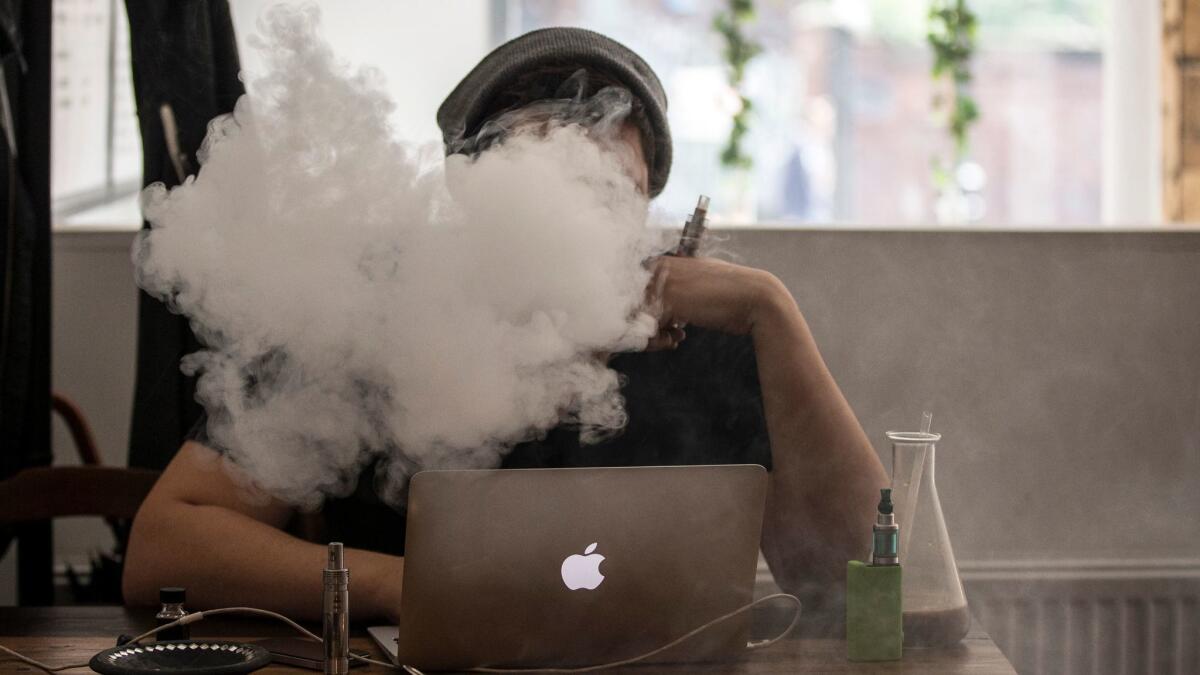Teens who vape are more likely to become teens who smoke — and smoke more often

- Share via
Los Angeles teens are giving health experts a fresh reason to fret about electronic cigarettes.
In a study of more than 3,000 students in L.A. County public schools, those who were into vaping at the beginning of their sophomore year were more likely to become traditional cigarette smokers over the next six months compared with their classmates who didn’t vape. The vapers were also more likely to become daily smokers and to smoke more cigarettes.
The findings, published Tuesday in the Journal of the American Medical Assn., suggest that public health officials have some justification for viewing e-cigarettes as a gateway to smoking for teens who would otherwise steer clear of tobacco products.
Dr. Tom Frieden, director of the Centers for Disease Control and Prevention, has been one of the most relentless proponents of this idea. Since at least 2013, he has warned that e-cigarettes — despite their innocuous image — have the potential to get teens hooked on nicotine. Once they’re addicted, they’re more susceptible to trying regular cigarettes.
The teen years are pivotal, because 90% of adult smokers picked up the habit in their teens, according to the Campaign for Tobacco-Free Kids. On top of that, the U.S. surgeon general warns that nicotine exposure during adolescence “may have lasting adverse consequences for brain development.”
Surveys and studies have validated Frieden’s fears. A report this summer in the journal Pediatrics found that high schoolers were six times more likely to start smoking cigarettes if they had a history of vaping than if they didn’t. The link between vaping and later smoking was particularly strong in students who said they had “no intention of smoking” when they were first interviewed.
And on Monday, Pediatrics published a study blaming flavors like “gummy bear” and “bubble gum” for making e-cigarettes seem appealing and less dangerous to kids in middle school and high school across the country.
The study, led by researchers from USC’s Keck School of Medicine, found that one-third of the 10th-graders surveyed had tried e-cigarettes at least once. Most of those students told interviewers they hadn’t vaped in the last 30 days, while 4% said they vaped once or twice in the last month and 5% said they vaped more often than that.
Six months later, 20% of the frequent vapers had become frequent smokers and an additional 12% had become occasional smokers, according to the study.
For the sake of comparison, about 2% of the students who had never vaped went on to become either occasional or frequent cigarette smokers during the same period.
And among those who vaped once or twice a month when they started 10th grade, 9% were occasional cigarette smokers and 5% were frequent cigarette smokers six months later, the researchers found.
Frequent vapers were also most likely to be smoking two or more cigarettes a day by the spring of their sophomore year — 12% of them did so, compared with 4% of the students who were occasional vapers at the beginning of the school year and 0.4% of those who didn’t vape at all.
This trend held up when the researchers analyzed the results based on the students’ cigarette smoking history at the start of the school year. For instance, among the 96% of students who started out as nonsmokers, fewer than 1% of those who never vaped became frequent cigarette smokers over the next six months, compared with 10% of those who were frequent vapers.
Even for those who started out as occasional or frequent smokers, the researchers found that the more a student vaped at the start of the school year, the greater the odds that they would be frequent cigarette smokers six months later.
The Los Angeles-area students in this study may not be representative of students across the nation, the study authors noted, so it’s not clear whether these findings can be generalized to the country as a whole.
Still, the results show that although some teens who make the leap from e-cigarettes to traditional cigarettes are just experimenting, others are getting hooked. This “may warrant particular attention in tobacco control policy,” the researchers concluded.
Follow me on Twitter @LATkarenkaplan and “like” Los Angeles Times Science & Health on Facebook.
MORE IN SCIENCE
Every year of smoking causes DNA mutations that make cancer more likely
Thanks to these bonobos, you can stop blaming your computer and iPhone for ruining your eyes
Elephant poachers are hard at work in Africa, and carbon dating proves it







